Exploring the Black Locust: Ecology and Management
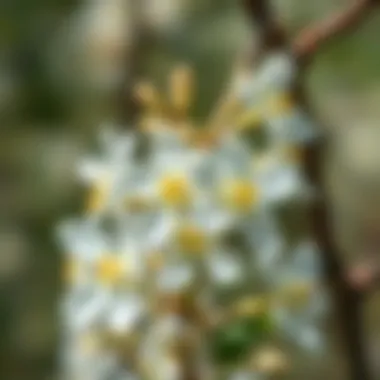

Intro
The world of forestry is not just about planting trees and waiting for them to grow. It’s a complicated interplay of ecology, management practices, and sustainable usage that forms the foundation of our planet's timber supply. One such tree that has garnered attention, particularly in the United States, is the black locust. This article embarks on a journey through the ecology, uses, and management of the black locust (Robinia pseudoacacia), while also shedding light on vital forestry practices that ensure sustainability and effectiveness in land stewardship.
The ecological contribution of the black locust extends far beyond its wood; it plays a crucial role in soil stabilization and biodiversity. With this in mind, understanding its impact on local environments is essential for those involved in forestry and land management. By disclosing the benefits and drawbacks associated with this species, we also aim to equip landowners and forestry professionals with the knowledge necessary for responsible management.
In the upcoming sections, we will delve into various forestry practices that highlight the importance of trees like the black locust, discover best practices for sustainable woodland stewardship, and explore innovative techniques combining modern science with traditional methods. For anyone keen on learning, this narrative promises to be a treasure trove of insights into maintaining the health and productivity of our forests.
Preface to Black Locust
The black locust tree, known scientifically as Robinia pseudoacacia, is not just another tree in the forest. It holds a unique position in diverse ecosystems and human applications. Recognized widely for its robust survival capabilities, this species is resilient and adaptable, having extended its reach far beyond its native southeastern United States. Understanding the black locust involves delving into its taxonomy, geographical prevalence, and the profound ecological roles it plays.
This section sets the stage for a deeper exploration of the black locust, shedding light on why it deserves attention in discussions about sustainable forestry and ecosystem management. The black locust contributes to soil regeneration, produces valuable timber, and can support a plethora of wildlife. However, this tree is not without its challenges, especially regarding its management and its potential invasiveness in certain regions. Thus, a thorough comprehension of its taxonomy and distribution is crucial for forestry professionals and ecologists alike.
Taxonomy and Classification
The taxonomy of the black locust places it in a larger classification that speaks volumes about its traits and relationships with other species. Belonging to the Fabaceae family, it is closely related to peas and beans. This is significant due to the nitrogen-fixing capabilities of legumes. The genus name, Robinia, honors Jean Robin, a French botanist who is credited with introducing this species to Europe.
To further appreciate the taxonomical standing of the black locust, here’s a simplified classification:
- Kingdom: Plantae
- Phylum: Angiosperms
- Class: Eudicots
- Order: Rosales
- Family: Fabaceae
- Genus: Robinia
- Species: R. pseudoacacia
This unique classification leads to an understanding of its features such as pinnately compound leaves and fragrant flowers. Such attributes not only catch the eye but also serve ecological purposes like attracting pollinators.
Geographical Distribution
When considering the black locust's geographical distribution, it’s essential to recognize its adaptability to different climates and soil types. Originally thriving in the southeastern U.S., it's now present across much of North America, Europe, and parts of Asia. This extensive distribution can be attributed to human activities, which have facilitated its spread beyond its native range.
In the United States, states like Kentucky, West Virginia, and Tennessee are known for their abundant black locust populations. However, it’s also important to note regions where it has taken root outside its original habitat, leading to concerns about its invasive potential. Areas such as the northeastern and midwestern U.S. have seen black locust trees become dominant in disturbed areas, necessitating careful management practices.
In summary, understanding the taxonomy and geographical distribution of the black locust is critical as it lays the foundation for deeper discussions on its ecological importance and the potential repercussions of its spread. As we progress through the article, these characteristics will be explored further in relation to their practical applications and management challenges.
Ecological Importance
The ecological importance of the black locust extends far beyond its striking aesthetic and timber value. To truly appreciate this species, one must consider how it fits into the ecosystem it inhabits. The black locust serves multiple roles, from supporting biodiversity to contributing positively to habitat health.
Habitat Contributions
Black locust trees are particularly adept at improving soil quality. They have a symbiotic relationship with Rhizobium bacteria, which enables them to fix nitrogen in the soil. This process enriches the soil, making it more fertile and beneficial for other plants in the vicinity. The trees thrive in a range of soil types, from sandy to clayey, making them quite adaptable. Their ability to grow in marginal lands gives them a unique position in restoration projects where other species might struggle.
Moreover, black locust trees provide essential shelter and nesting sites for various animals. Birds, for instance, are often seen perched on their branches. In addition, the dense foliage of these trees offers excellent cover for ground-dwelling wildlife, allowing different species to thrive. Furthermore, their flowers produce nectar that attracts pollinators, such as bees, contributing to the overall health of nearby flora and fauna.
Biodiversity Support
When we talk about biodiversity support, the black locust stands out as a keystone species within certain environments. Its presence can significantly enhance the biodiversity of an area, creating a more stable ecosystem. Not only does the tree provide food and habitat for wildlife, but it also helps establish a microhabitat that encourages other plant species to flourish alongside it.
The quick growth and adaptability of black locust often make it a pioneer species. After disturbances such as fire or logging, black locust can take root rapidly, stabilizing the soil and paving the way for slower-growing and more sensitive species to establish themselves. This process, known as ecological succession, showcases the tree's vital role in fostering a diverse plant community, which is fundamental for a resilient ecosystem.
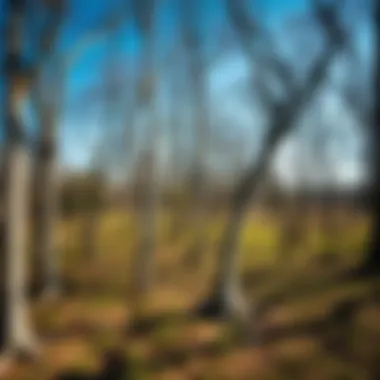
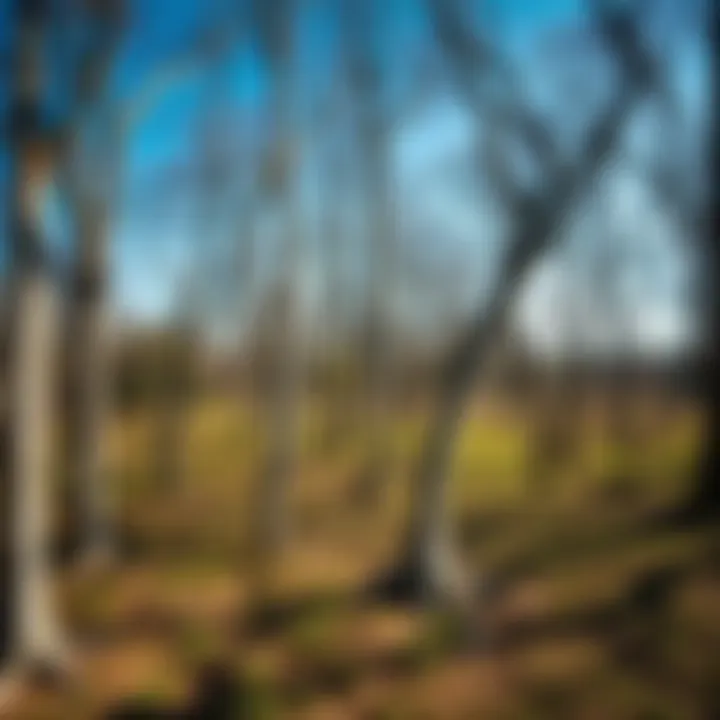
"In ecological terms, supporting biodiversity is akin to having a safety net. The more diverse a habitat, the more resilient it becomes to changes and disturbances."
To summarize, the black locust's contributions to habitat health and biodiversity are critical. Its role in enriching the soil and supporting various wildlife forms a legacy that not only sustains its ecosystem but also enhances the overall ecological footprint of the areas it inhabits. As discussions about the management and use of black locust continue, recognizing its ecological importance will be essential for fostering sustainable forestry practices and maintaining the delicate balance within our natural environments.
Characteristics of Black Locust
Understanding the characteristics of black locust is essential for anyone interested in the ecological and practical aspects of this tree species. It’s not just about what the tree looks like; it’s about how these features influence its growth, uses, and interactions within its ecosystem. Exploring these traits helps facilitate better management practices and utilizes the tree's potential to its fullest.
Physical Traits
Black locust trees can be distinguished by a set of unique physical traits that contribute to their appeal and functionality. With rough, furrowed bark, these trees present a rugged appearance that tends to darken with age. Typically, a mature black locust can reach heights of up to 100 feet, boasting a broad crown that provides ample shade. These trees are often characterized by their pinnately compound leaves comprised of up to 25 leaflets, giving them a lush and dense look during the growing season.
The flowers of the black locust are perhaps its most stunning feature. These white to pale yellow, fragrant blossoms appear in spring and can blanket the tree in a cloud-like display. Not only are these flowers visually striking, but they are also a magnet for pollinators like bees, which play a critical role in the ecosystem. Moreover, black locust produces seed pods that can grow to be 3–4 inches long, containing several seeds that help in natural reproduction.
Additionally, black locust is well-known for its hard, durable wood. Often referred to as a sustainable timber source, the wood is resistant to rot, making it ideal for outdoor uses such as fencing and decking. Some folks even claim it's like the Arnold Schwarzenegger of trees—tough and reliable.
Growth Patterns
When it comes to growth patterns, black locust exhibits remarkable adaptability. It thrives in various soil types, often favoring well-drained, sandy soils but holds its own even in clayey ground. This flexibility makes it a popular choice for reforestation projects aimed at restoring depleted landscapes yet it grows faster in full sunlight. Regularly, black locust can achieve an impressive growth rate of around 24 inches per year under optimal conditions. You can't ignore that kind of performance!
One fascinating aspect of this species is its ability to influence soil nutrient levels through a symbiotic relationship with nitrogen-fixing bacteria, which live in root nodules. This capability allows black locust to enhance soil fertility over time, benefitting neighboring plants and the broader ecosystem.
In terms of reproduction, black locust tends to dominate through its prolific seeding habit. Even if you cut a black locust down, it often responds vigorously through suckering, sending out new shoots from the roots. This means that alongside careful management measures, black locust can be very resilient in its quest to thrive.
"Black locust stands as a testament to nature's ability to thrive and adapt in a variety of conditions, shaping both its environment and the creatures that depend on it."
Understanding these characteristics isn't just about appreciation; it's about recognizing the role these traits play in fostering sustainable forestry practices. Black locust embodies a unique blend of ecological advantage and practical utility, making its management a topic deserving of careful consideration.
Uses of Black Locust
The black locust tree is not just a pretty face in the forest; it stands strong as a multi-functional species with extensive uses that reach beyond woodlands. Understanding its various applications is essential for effective forest management and ecological conservation. The black locust serves industries ranging from timber to landscaping, making it a versatile asset for landowners and professional foresters alike.
Timber Production
When people talk about timber, black locust deserves a spotlight. Its wood is what many would call “tough as nails”—it’s incredibly durable, resistant to decay, and even repels insects to a degree. This natural resilience means that black locust timber is highly sought after for outdoor applications, such as fencing, decking, and even boat building. The wood’s fine grain and golden hue make it not just functional but also quite attractive.
One specific aspect that sets black locust apart is its high strength-to-weight ratio; it can bear a substantial load without bending or breaking. This quality is a compelling factor for builders and craftsmen choosing materials for projects that require both endurance and aesthetic appeal. Some might say it's like finding gold in the hills when sourcing the right materials. However, it is worth remembering that while the advantages are numerous, there are considerations regarding sustainable harvesting practices to prevent overexploitation.
Environmental Applications
Reforestation
Reforestation efforts benefit significantly from introducing black locust into new areas. A key characteristic of this species is its ability to thrive in degraded soils, helping breathe life back into barren landscapes. When planted in areas needing restoration, black locust trees can improve the soil structure and fertility through their nitrogen-fixing capabilities. This means they can enrich the ground, paving the way for other plant species to establish themselves.
This unique feature not only aids in reforestation but also in creating diverse ecosystems. As the black locust takes root, it can support various wildlife, providing essential habitats. Every tree counts in restoring our environment, and black locust is a popular choice due to its rapid growth rate, making it a valuable asset for land restoration projects. Yet, while its rapid growth transforms landscapes, it’s crucial to monitor its spread to prevent it from becoming invasive in susceptible ecosystems.
Soil Erosion Control
Controlling soil erosion is another area where black locust shines. It has a sprawling root system that excels in stabilizing soil, making it a favorite among soil conservationists. As the rains fall and winds blow, the hold that these trees provide can keep soils intact, especially in areas prone to landslides or flash flooding. It's like having nature’s own security system against the elements.


Furthermore, black locust’s dense canopy offers shade, reducing evaporation from the soil and maintaining a humid microclimate under its branches. This characteristic benefits not only the black locust itself but also surrounding flora that might be struggling under harsh conditions. That said, while beneficial, this strategy requires thoughtful integration with existing ecosystems to ensure harmony—for example, avoiding situations where black locust could outcompete native species.
Ornamental Use
In addition to its practical applications, black locust is also celebrated in landscape design for its ornamental value. The tree can flourish beautifully, donned with fragrant white flowers that bloom in spring, inviting butterflies and bees to the garden. When planted in parks or gardens, it brings a touch of elegance and vibrancy that appeals to both designers and nature lovers. For gardeners, a row of black locust trees can create a splendid avenue or canopy, transforming ordinary spaces into works of living art.
However, it’s important to balance that beauty with considerations for maintenance and site selection—since black locust can grow quite large, appropriate planning is vital to ensure it fits seamlessly into its surroundings. With a bit of foresight, utilizing black locust as an ornamental choice can enhance both the aesthetics and ecological function of a garden or urban setting.
In summary, the diverse uses of black locust—from robust timber to its role in environmental applications showcase its importance in forestry and land management. Understanding these uses allows for better stewardship of resources, benefiting not only the economy but also the environment.
Cultural Significance
The cultural significance of the black locust goes beyond its ecological roles and commercial uses; it stretches into the realms of tradition, history, and integrity within communities. Understanding these dimensions is paramount for those working with this species in various capacities.
Historical Context
Historically, the black locust has earned its keep as a sturdy wood favored by many indigenous and local cultures. Native Americans utilized its timber for constructing canoes and tools, taking advantage of its natural resistance to decay. Such applications underscore the tree's durability, making it vital for early settlers as well. Even now, its wood is regarded highly for furniture and flooring, a testament to its lasting legacy.
Interestingly, it was also introduced to Europe in the early 1600s, where it found a new life. European foresters admired its rapid growth and adaptability, integrating it into local cultures as a means of sustainable forest management. The black locust is often associated with landscapes that symbolize resilience and innovation.
"The black locust tree serves not only as a resource but as a symbol of ingenuity and adaptation across cultures."
Current Applications
In modern times, the black locust continues to be relevant in various cultural contexts. Its use in landscaping showcases not just its aesthetic appeal, but its practical benefits in soil improvement and erosion control. Landscape architects often seek this tree for planting in urban areas due to its hardiness and ability to thrive in poor soils.
Moreover, its role in community projects is noteworthy. Many local organizations plant black locusts as part of reforestation efforts, effectively connecting communities to their environment. The leguminous properties of the tree enrich the soil, promoting biodiversity, which various community initiatives champion. The tree’s blossoms, rich in nectar, also attract pollinators, further weaving them into the social fabric of local ecology and culture.
Black locust wood is increasingly recognized for its value in artisanal crafts. Crafters and artisans appreciate its workability and durability, giving way to unique handcrafted items that link back to historical methods of production.
In summary, understanding the cultural significance of black locust is crucial, particularly for forestry professionals and academics. It highlights the interconnections between ecology, community, and tradition, urging a deeper consideration in management practices.
Management Practices
Effective management practices are vital when considering the sustainable use of the black locust. This tree species, while offering numerous benefits, also presents challenges that require careful consideration and strategic planning. To harness its potential, it's essential to integrate sustainable methods that not only promote the growth and health of black locust trees but also protect the surrounding ecosystems.
A well-thought-out approach to management can enhance timber quality, improve biodiversity, and mitigate the risk of invasive spread. Proper decisions in management ultimately impact economic gains and ecological stability, making it crucial for landowners and forestry professionals to remain informed about effective techniques and ongoing research in the field.
Sustainable Harvesting Techniques
Sustainable harvesting techniques for black locust focus on methods that allow for the ongoing availability of timber while safeguarding ecological integrity. One method is selective logging, where only specific trees are harvested, ensuring that the overall forest structure remains intact. This practice minimizes disturbances and promotes natural regeneration.
- Thinning: This process involves selectively removing trees to reduce competition for resources, which can help in boosting the growth of healthier trees.
- Clear-cutting with Caution: If necessary, clear-cutting can be employed, but it must be executed with a recovery plan in place. For black locust, quick replanting with native species can help mitigate potential negative impacts on biodiversity.
Maintaining adequate records of harvest yields and conducting regular assessments can aid in identifying successful practices and areas needing adjustment. Considerations like timing and seasonality can also play a significant role in the sustainability of harvesting techniques, as harvesting during dry seasons reduces soil compaction and erosion.
Pest and Disease Management
Managing pests and diseases is critical in ensuring the health of black locust populations. An integrated pest management (IPM) approach is often the most effective strategy. This involves monitoring pest populations and employing a combination of biological, chemical, and cultural practices aimed at maintaining pest levels below those that would cause unacceptable damage.
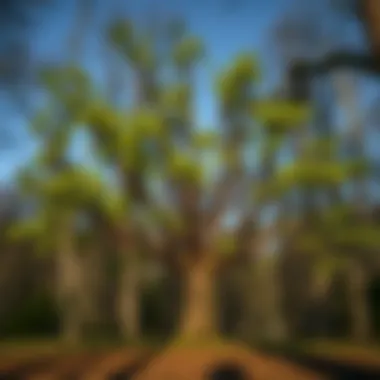
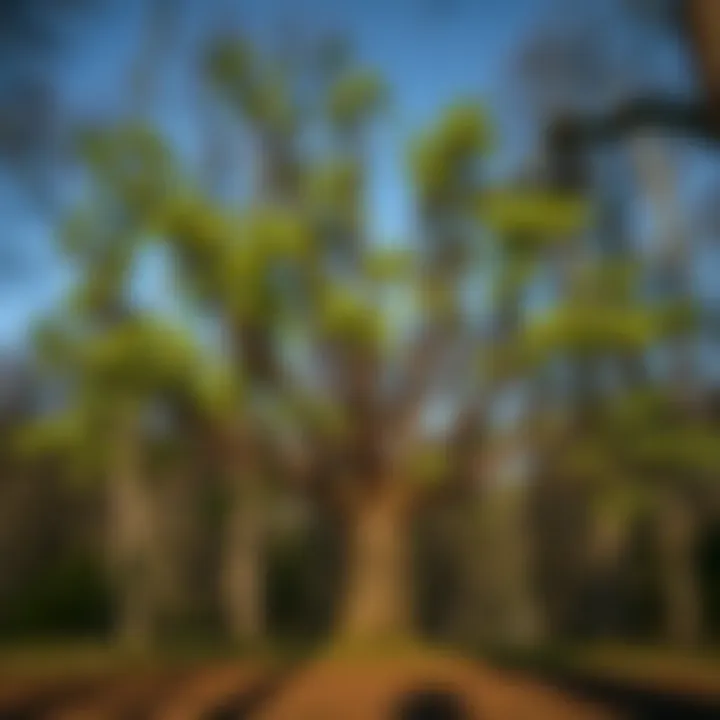
- Biological Control: Introducing natural predators, such as certain bird species or beneficial insects, can help control pest populations without reliance on chemicals.
- Cultural Practices: Planting black locust alongside other tree species can help confuse pests, disrupting their life cycles and reducing infestations.
- Regular Monitoring: Conducting regular health checks on the trees for signs of pest damage or disease symptoms can allow for early intervention and treatments, thus preventing an outbreak that could compromise the entire crop.
It's essential for land managers to stay updated on emerging threats and management practices that can help safeguard against both established and new pest issues.
By focusing on these management practices, landowners and professionals can not only maximize economic return but also protect the ecological health of the systems where black locust thrives.
Challenges Associated with Black Locust
The black locust is not just celebrated for its valuable contributions to ecology and industry; it also brings with it several challenges that merit close examination. Understanding these challenges is crucial for anyone engaged in the management and sustainable use of this species. While the tree offers numerous environmental benefits, it can also present significant risks, especially in regions where it is not native. This section delves into two primary challenges: the invasive species concern and the environmental impacts associated with black locust proliferation.
Invasive Species Concern
Black locust, originally hailing from the southeastern United States, has made its way into various parts of the world, often outside its native range. In many places, it is considered an invasive species. These trees can outcompete native flora, leading to a decline in biodiversity. The roots and sprawling nature of black locust allow it to establish dominance, crowding other species out of light and nutrients.
- Competitive Edge: Its rapid growth rate gives it a distinct advantage over slower-growing native species. When they take root, they can swiftly proliferate, forming thickets that make it tough for other plants to survive.
- Disruption of Ecosystems: Once established, black locust can alter ecosystem dynamics, negatively affecting soil quality, water tables, and local flora and fauna.
- Management Difficulties: For landowners and forest managers, tackling black locust’s spread can be a daunting task. Effective control measures require ongoing monitoring and can involve herbicides, manual removal, or targeted burning. However, these methods can be costly and may have unintended consequences on the surrounding environment.
It’s essential for forestry professionals and landowners to recognize the signs of invasion and implement management strategies proactively. Ignoring these issues could lead to significant ecological degradation.
Environmental Impacts
The introduction and expansion of black locust into non-native areas raise several environmental concerns. While the species can provide certain ecological benefits, such as soil stabilization and nitrogen fixation, the consequences of its invasive potential cannot be overlooked.
- Soil Health: Black locust fixes nitrogen, which can benefit adjacent species by enhancing soil fertility. However, its dominance can lead to an unbalanced ecosystem where native plants struggle, eventually resulting in a decline of soil health overall.
- Water Usage: This tree can dramatically impact local water tables due to its high water consumption. Areas infested with dense populations of black locust might experience altered water availability for both plants and animals.
- Wildlife Effects: Many native species depend on specific habitats for survival. The shift in vegetation caused by the dominance of black locust can disrupt local wildlife, pushing some species to the brink while rendering the habitat less hospitable.
Proper management of black locust is more than just about controlling an invasive plant; it’s about maintaining the balance of entire ecosystems.
Thus, understanding these environmental impacts is vital for effective management. As we look to balance the benefits and risks associated with black locust, the focus should be on long-term ecological health and biodiversity preservation. This requires a nuanced approach, informed by solid research and best practices in forestry and land management.
For further reading on the ecological implications of invasive species, consider visiting National Park Service or USDA Forest Service.
Finale
The conclusion serves as a vital encapsulation of the multifaceted role of the black locust in both ecological and practical domains. It pulls together the intertwining threads of information presented throughout the article, highlighting the species’ significance within its native habitat and its broader implications in global forestry contexts. As we close this exploration, we need to reflect on a few critical elements.
The Path Forward for Black Locust Management
With the increasing recognition of the black locust's capabilities, it's paramount to emphasize a balanced management approach. Sustainable practices must be the cornerstone of future strategies. This can be achieved by:
- Implementing monitoring systems to track the health of black locust populations and their effect on surrounding ecosystems.
- Encouraging responsible planting in regions where black locust can thrive without disrupting native flora. Care needs to be taken that it doesn’t turn into an invasive species in those areas where it might not be welcome.
- Educating landowners and forestry professionals about the potential benefits and risks associated with black locust cultivation. The aim is to equip them with the right tools and knowledge, enabling effective management while minimizing adverse outcomes.
Moving forward looks promising as long as stakeholders engage with science-based management practices. This ensures that the black locust remains a beneficial asset rather than a challenging liability.
Balancing Benefits and Risks
When discussing the black locust, one cannot ignore the tug-of-war between its numerous benefits and potential risks. On one hand, its uses in timber production and soil rehabilitation shine through as significant contributions to forestry and environmental resilience.
However, there's a flipside. The tree’s rapid growth and ability to thrive in various soil types can lead to it overtaking areas where it’s not originally from. On the environmental front, we must consider:
- Competition with native species, which could lead to biodiversity loss. It is crucial to develop strategies that allow for natural habitats to flourish alongside controlled black locust growth.
- Monitoring pest populations, as the introduction of black locust into new territories could exacerbate local pest problems or lead to the establishment of non-native pests.
In summary, while the black locust offers substantial economic and ecological benefits, it's equally important to recognize and navigate the associated risks. Thoughtful deliberation of both sides of the coin will pave the path for effective management practices that optimize advantages while mitigating disadvantages. Understanding this balance is critical to harnessing the full potential of the black locust in sustainable forestry practices.
"The key to managing black locust lies in understanding its role within the ecosystem and continually adapting our strategies to the changing environment."
By fostering an open dialogue among forestry professionals, environmental advocates, and policymakers, we can ensure that black locust management becomes a model of how thoughtful stewardship can benefit both the economy and the environment. For more insights, visit: Wikipedia and Britannica.















